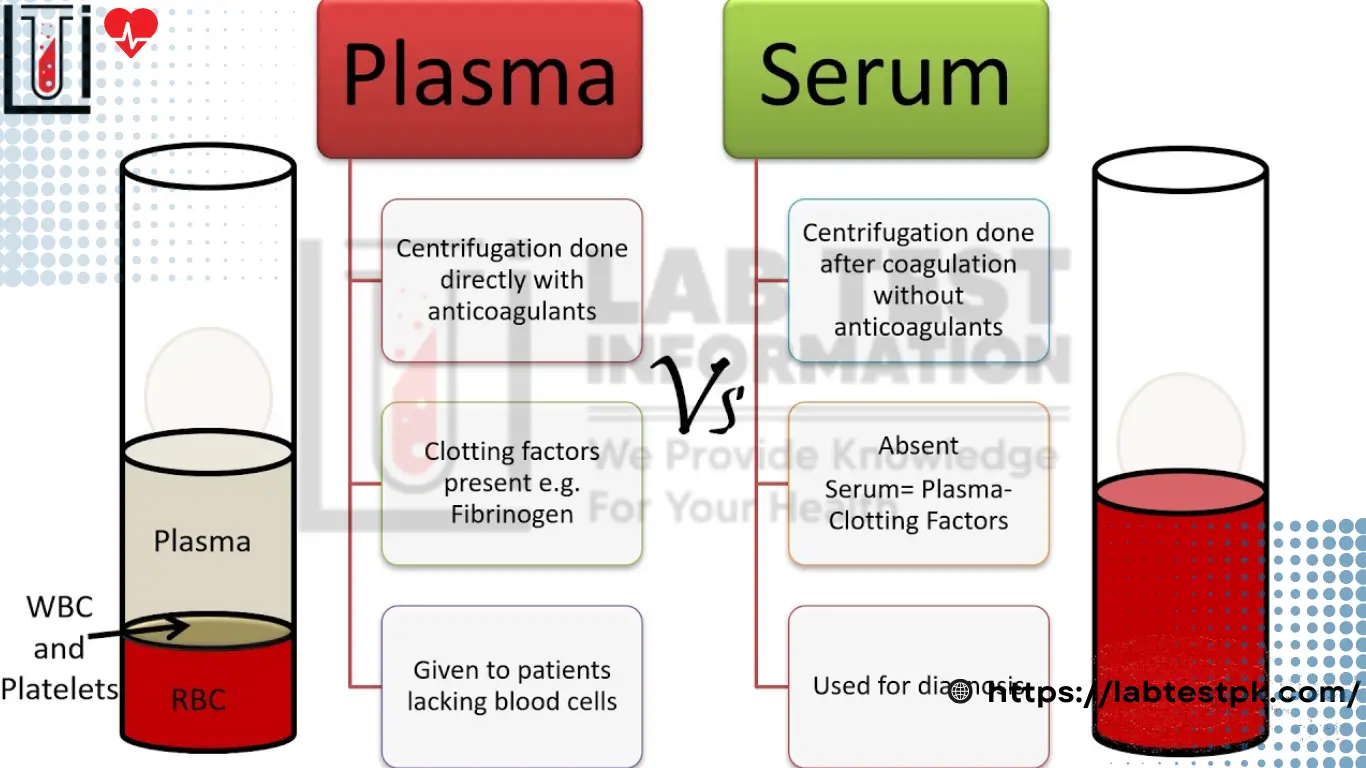Table of Contents
TogglePlasma and Serum Difference
Plasma and Serum Difference, Plasma (PLAZ-muh) is The clear, yellowish, fluid Past of the blood that carries the blood cells. Serum SEER-Um The clear liquid Part of the blood that remains after blood cells and clotting Proteins have been removed. It is a liquid Part of coagulated blood.
Difference B/W Plasma and Serum:
| Plasma | Serum |
| Plasma is the Part that Contains clotting factors. Fibrinogen is resent. Anticoagulants are required for the separation of plasma from the blood. Example: EDTA, Heparin, Citrate, |
Serum is the Part of blood that does not contain clotting factors. Fibrinogen is absent, Na-anticoagulants are required for the separation of serum from blood. |
| Plasma is acquired from the spinning before clotting and is less time-consuming. | Serum is acquired from Spinning after clotting and is time-consuming. |
| Volume: Plasma takes 55% of the total volume of blood. |
Volume: The volume of serum is less than that of plasma. |
| Uses: Plasma is used for tests and also Plasma transfusion is done for trauma patients and patients with severe liver disease. |
Uses: Serum is used for tests. Example: Enzymes test Hormon tests. |
| % of water: Plasma contains 92-95% of water. Plasma = Serum + clotting factors. |
% of water: Serum contains 90% water hormone, Protein minerals, etc. Serum = Plasma+ clotting factors. |
| Ability: It has availability to clot. |
Ability: Don’t have the ability to clot further. |
| Stability: It is considered less stable (especially) for longer Storage. |
Stability: It is considered more Stable-the gold standard for biobanking. |
| Platelets one cell (WBCs) can contaminate the liquid fraction. It can be prepared as soon as it can be mixed thoroughly. |
The cleaner sample was depleted” of cells and cell remnants, but latent clotting can lead to fibrin formation with 30 minutes delay for a clot formation. |
| Composition: The composition of ions is representative of the circulating blood. |
Composition: Clot retraction elevates. Potassium level relative to its plasma value. |
MCQ,s
Density of Plasm is ion electron pair/cm3?
(a) ✓ 10-12
(b) 10-20
(c) 10-21
(d) 102
Plasma has collisions?
(a) Continuous
(b) Frequent
(c) ✓ on frequent
(d) Both a and b
80% of Plasma behavior can be observed through?
(a) Brownian model
(b) ✓ Crude model
(c) Watson Crick model
(d) Ruther ford model
Uncrude model identity of individuals Particle is?
(a) ✓ Neglected
(b) Discussed
(c) not exist
(d) Existed
It considered more stable- gold standard is?
(a) Plasma
(b) ✔ Serum
(c) Antiserum
(d) blood
In ordinary fluid collision between Particles are?
(a) ✓ Frequent
(b) Infrequent
(c) Periodic
(d) Regular
In humans. all of the following plasma Proteins have oligosaccharide chains attached, Except?
(a) Transferrin
(b) ✓ Albumin
(c) C-Reactive Proteins
(d) Ceruloplasmin
Takes 55% of total volume of blood?
(a) ✓ Plasma
(b) Serum
(c) Water
(d) Body
Serum contain % of water…?
(a) 80%.
(b) 50%
(c) 20%
(d) ✓ 90%.
Fibrinogen factor is Present in?
(a) ✓ Plasma
(b) both
(c) Serum and Antiserum
(d) None


[…] a needle when the vein is prominent. Collect the 3 to 5ml blood Sample in Gel Tube or Red Top Tube. Centrifuge the blood sample and separate the serum оr plasma. And with that, you can perform the test on the […]
[…] No. 3: What percentage of plasma protein in […]
Thanks for the ideas you have shared here. On top of that, I believe usually there are some factors which will keep your automobile insurance premium lower. One is, to bear in mind buying cars that are inside good list of car insurance corporations. Cars which are expensive are definitely more at risk of being lost. Aside from that insurance is also based on the value of your car, so the more costly it is, then higher a premium you only pay.
Your posts consistently provide value and practical advice.
Thanks for posting. I really enjoyed reading it, especially because it addressed my problem. It helped me a lot and I hope it will help others too.
Thank you for writing this post. I like the subject too.
May I request that you elaborate on that? Your posts have been extremely helpful to me. Thank you!
[…] in the blood, monocytes are the largest in terms of size. Monocytes enter different parts of the body and try to protect the body from various diseases. Since they are capable of taking in large molecules, they are also called […]
[…] 3 to 5ml blood in a gel Tube. Centrifuge the blood sample. After centrifugation, the serum, and used for further analysis and to find out the value of total […]